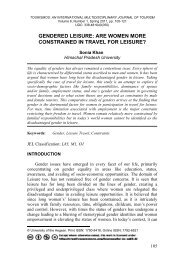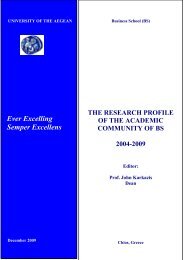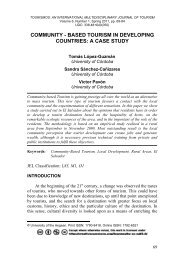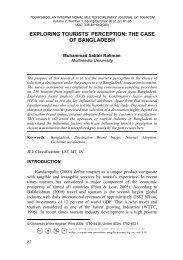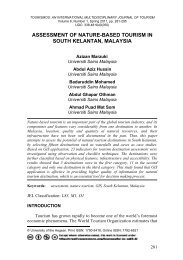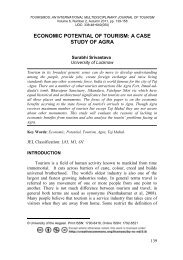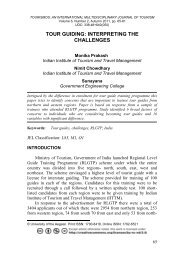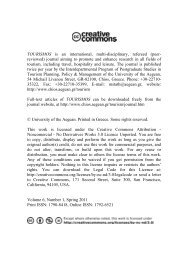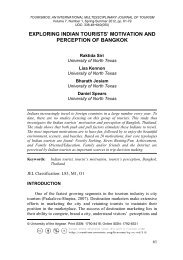COMMONS DEED
COMMONS DEED
COMMONS DEED
You also want an ePaper? Increase the reach of your titles
YUMPU automatically turns print PDFs into web optimized ePapers that Google loves.
<strong>COMMONS</strong> <strong>DEED</strong><br />
Attribution Non-commercial No Derivatives 3.0 (by-nc-nd) Unported<br />
You are free:<br />
to Share — to copy, distribute and transmit the work<br />
Under the following conditions:<br />
Attribution. You must attribute the work in<br />
the manner specified by the author or licensor<br />
(but not in any way that suggests that they<br />
endorse you or your use of the work).<br />
Noncommercial. You may not use this<br />
work for commercial purposes.<br />
No Derivative Works. You may not alter,<br />
transform, or build upon this work.<br />
• For any reuse or distribution, you must make clear to<br />
others the license terms of this work. The best way to<br />
do this is with a link to this web page.<br />
• Any of the above conditions can be waived if you get<br />
permission from the copyright holder.<br />
• Nothing in this license impairs or restricts the author's<br />
moral rights.<br />
Download the Legal Code for this Licence at:<br />
http://creativecommons.org/licenses/by-nc-nd/3.0/legalcode
TOURISMOS: AN INTERNATIONAL MULTIDISCIPLINARY JOURNAL OF TOURISM<br />
Volume 6, Number 3, Winter 2011, pp. 13-36<br />
UDC: 338.48+640(050)<br />
EARNINGS TARGETS IN SPANISH HOTEL<br />
INDUSTRY: AN APPROXIMATION<br />
Laura Parte Esteban 1<br />
Spanish National University for Distance Education (UNED)<br />
María Jesús Such Devesa<br />
University of Alcala<br />
Pilar Alberca Oliver<br />
Spanish National University for Distance Education (UNED)<br />
In this paper, two earnings targets - avoiding losses and earnings decreases - are<br />
analyzed in Spanish hotel industry. The methodology used as a proxy to earnings<br />
targets is frequency histograms. Particularly, the existence of a “kink” in the<br />
distribution of reported earnings around zero is examined. The access to financial<br />
resources to start or to consolidate expansion policies is an important issue to the<br />
companies belonging to our sample. This specific scenario allows us to study how<br />
to reach earnings benchmarks under debt covenant hypothesis. Likewise, Spanish<br />
tourism sector is characterised by small firms and most of them are governed by<br />
families. We explore the relationship between earnings benchmarks and this<br />
particular ownership structure. Finally, we examine the presence of auditors (and<br />
Big4 auditors) as an earnings quality tool.<br />
Keywords:<br />
earnings benchmarks, frequency histograms, Spanish hotel<br />
industry<br />
JEL Classification: L83, M1, O1<br />
INTRODUCTION<br />
The role that financial information plays in global market is wellknown.<br />
The current financial crisis has called to attention to the quality of<br />
the accounting information reported by firms over the world. The<br />
transparency of the information available to make appropriate judgments<br />
about firms‟ performance by investors is an open question.<br />
Our study focuses on the quality of the financial reporting.<br />
Particularly, this paper examines earnings benchmark in the Spanish hotel<br />
industry. The benchmarking literature uses small positive differences<br />
© University of the Aegean. Print ISSN: 1790-8418, Online ISSN: 1792-6521<br />
13
Laura Parte Esteban, María Jesús Such Devesa & Pilar Alberca Oliver<br />
between reported earnings and any benchmark as a measure of earnings<br />
quality. The literature considers three basic earnings benchmarks: report<br />
small positive profits, report small increases in profits and “meet or beat”<br />
analysts‟ forecasts (Burgstahler and Dichev 1997; Degeorge et al. 1999;<br />
Barth et al. 1999; Myers et al. 2007).<br />
The motivations that managers present to achieve earnings<br />
benchmark have extensively analyzed. Research documents that firms<br />
that consistently meet or beat prior period earnings have higher priceearnings<br />
ratios or market-multiples than matched samples (Barth et al.<br />
1999; Myers et al. 2007). It is also noted that only if firms meet analyst<br />
expectations consistently, they are rewarded with high stock prices in the<br />
market (Kasznik and McNichols 2002). In contrast, if firms eventually<br />
miss a target, they loss immediately the market-reward (Myers et al.<br />
2007). Recent studies reveal that markets incentives are the most<br />
important incentive to engage in earnings management. However, bonus<br />
plans, debt covenant hypothesis and political cost also explain an earning<br />
management strategy (Watts and Zimmerman 1986).<br />
Considerable effort was spent on detecting the factors that can<br />
mitigate earnings management. Factors related to the accounting<br />
standards quality, the legal structure, the investor rights, the ownership<br />
equity, the importance and develop of equity markets, the enforcement<br />
mechanisms and the corporate governance, among others, explain<br />
different levels of earnings quality (e.g. Leuz et al. 2003).<br />
This paper focuses on earnings benchmarks using a sample from<br />
Spanish hotel industry firms for the period 1999-2003. Several reasons<br />
justify focusing on Spanish hotel industry. Firms belonging to this<br />
industry are immersed in a growing process over local markets and<br />
abroad. The access to new financial resources to start, to promote, to<br />
intensify or to consolidate expansion policies could be a strong<br />
motivation to manage earnings. Also atomization characterizes Spanish<br />
hotel industry and that means weaker financial information regulation, at<br />
least far away from the regulation affecting large and audited firms.<br />
Finally, to avoid earnings tax paying could be a strong factor to increase<br />
earnings without limit (Coppens and Peek 2005).<br />
The scenario provided by hotel industry allows us to design a specific<br />
study. First, we examine the avoiding losses hypothesis and earnings<br />
decreases hypothesis. The methodology used is frequency histograms.<br />
Particularly, the existence of a “kink” in the distribution of reported<br />
earnings around zero is analyzed (Burgstahler and Dichev, 1997).<br />
Second, earnings targets are studied in the specific framework faced<br />
by Spanish hotel industry. The access to financial resources is an<br />
14
TOURISMOS: AN INTERNATIONAL MULTIDISCIPLINARY JOURNAL OF TOURISM<br />
Volume 6, Number 3, Winter 2011, pp. 13-36<br />
UDC: 338.48+640(050)<br />
important restriction in their expansion abroad. In this context, we use<br />
leverage as a proxy to debt covenants and we explore if higher leverage<br />
firms incur more in earnings management than lower leverage firms.<br />
Third, Spanish hotel firms present a particular ownership structure.<br />
As well as most of the firms are characterized by a small size, family<br />
structure is the most predominant form to manage the firm. Our next<br />
objective is to analyze the association between reaching earnings<br />
benchmarks and the family‟s governance.<br />
There are two competing theories about the incentives that<br />
managerial ownership provides for accounting choices: an entrenchment<br />
effect and an incentive alignment effect. These two effects predict<br />
different directions for the association between ownership concentration<br />
and earnings quality. Entrenchment effect theory suggests that controlling<br />
shareholders extrapolate private benefits at the expense of minority<br />
shareholders. In contrast, alignment effect theory suggests that controlling<br />
shareholders‟ benefits are closely tied to firm value. The evidence on<br />
which effect dominates is mixed.<br />
Finally, we examine the association between earnings targets and<br />
audited-firms versus non-audited firms. Extent research examines the<br />
auditor function to mitigate earnings management. One of the most<br />
commonly studied features of auditors are audit firm size. Generally,<br />
studies support that firms audited by large auditor firms are associated to<br />
less earnings than firms with non-Big4 auditors (DeAngelo 1981a;<br />
Krishnan 2003). In this context, the presence of Big 4 auditors is taken<br />
into account.<br />
The results show a statistically small number of firms with small<br />
losses and a statistically large number of firms with small profits. The<br />
evidence is more accentuated by higher leverage firms. Finally, for nonaudited-firms<br />
earnings benchmarks are more pronounced than for auditedfirms.<br />
Generally, the results suggest that Spanish hotel industry is concern<br />
about the earning figure in the financial reporting.<br />
In this paper we contribute to this literature in two main ways. A<br />
further contribution of the study is to provide initial evidence on whether<br />
the phenomenon of avoiding losses and earnings decreases is important in<br />
a fundamental sector of the Spanish economic activity (more than 12% of<br />
Gross Domestic Product, 12% of employment and covers around 60% of<br />
Spanish commercial deficit during 2009). Most previous studies proceed<br />
from listed companies. Second, this paper provides evidence about the<br />
relationship between earnings benchmarks and debt covenant hypothesis.<br />
Also ownership structure and the presence of auditors are analyzed. In<br />
15
Laura Parte Esteban, María Jesús Such Devesa & Pilar Alberca Oliver<br />
sum, this paper provides an initial approximation to earnings benchmarks<br />
in the Spanish tourist sector.<br />
The remainder of this paper is organized as follows. Section 2<br />
discusses prior literature. Section 3 describes the design of our empirical<br />
research and sample selection. Section 4 discusses the descriptive<br />
statistics and the findings of our empirical tests, and Section 5 concludes.<br />
LITERATURE REVIEW<br />
Background<br />
The earning quality around the world is still an open question.<br />
Market‟s regulators (such as Securities Exchange Commission) have<br />
expressed their concern about the reporting of financial information by<br />
firms due to their implication for global markets. Earnings are widely<br />
used as a key performance indicator of business success and stakeholders<br />
use earning figure to multiple purposes.<br />
This paper covers earnings benchmark as a measure of earnings<br />
quality in Spanish hotel industry. Frequency histogram is the most<br />
common methodology to identify weather managers trying to achieve<br />
earnings targets. Burgstahler and Dichev (1997) document a “kink” in the<br />
distribution of reported earnings around zero. They find a statistically<br />
small number of firms with small losses and a statistically large number<br />
of firms with small profits. Burgstahler and Dichev (1997) interpret this<br />
evidence as firms with unmanaged earnings just less than the heuristic<br />
target of zero intentionally manage earnings just enough to report a small<br />
profit.<br />
In the same way, small earnings increases (or avoiding small<br />
decreases in earnings) are considered as a proxy for earnings<br />
management. The hypothesis is based on the finding of a statistically<br />
unusual low number of firms with small decreases in earnings in relation<br />
to small increases in earnings. Similar predictions are considered for<br />
meeting or beating the analysts´ forecast.<br />
Findings of Burgstahler and Dichev (1997) have been documented<br />
using large samples of firms and selected under different restrictions. For<br />
example, in US context, Ayers et al. (2006) get some evidence consistent<br />
with an association between earnings management through the use of<br />
accruals and these targets. Kerstein and Rai (2007) and Jacob and<br />
Jorgensen (2007) find that the kink in earnings around zero is strongest in<br />
the fourth quarter. Donelson et al. (2009) provide direct evidence of an<br />
association between earnings management and discontinuities in the<br />
16
TOURISMOS: AN INTERNATIONAL MULTIDISCIPLINARY JOURNAL OF TOURISM<br />
Volume 6, Number 3, Winter 2011, pp. 13-36<br />
UDC: 338.48+640(050)<br />
distribution of analyst forecast errors, earnings changes, and earnings<br />
levels.<br />
Not only earnings benchmarks have been documented in local<br />
samples, but also in samples covering several countries. For example,<br />
Burgstahler et al. (2006) using a sample of private and public firms from<br />
13 European Union countries, find that private companies manage<br />
earnings more which is consistent with less pressure for earnings quality.<br />
Coppens and Peek (2005) using a sample of private firms in eight<br />
European countries, find that in absence of capital market pressures, firms<br />
still have incentives to manage earnings. They argue that private firms<br />
avoid reporting small losses and tax incentives are a strong factor to<br />
engage in earnings management.<br />
Prior literature suggests that meeting or beating targets has positive<br />
market consequences. Barth et al. (1999) and Myers et al. (2007) notice<br />
that firms that consistently report earnings increases relative to the prior<br />
year or relative to the same quarter of the prior year receive a price<br />
premium. The positive market consequences have risen as one of the most<br />
important incentive by managers to incur in earnings management.<br />
The positive accounting theory literature examines management<br />
motives for making accounting choices (see Watts and Zimmerman<br />
1986). Incentives such as compensation contracts, debt contracts, and<br />
political costs explain firms´ accounting choices when there are agency<br />
costs and information asymmetry.<br />
Debt covenant hypothesis suggests that firm closer to violating debt<br />
covenants will make income-increasing accounting choices to avoid<br />
covenant violations. In this context, Sweeney (1994) provides evidence<br />
that firms make income-increasing accounting choices as they move<br />
closer to violating debt covenants. DeFond and Jiambalvo (1994) find that<br />
working capital accruals are higher in the year prior to the year that a firm<br />
reports a covenant violation in its annual report. In contrast, DeAngelo et<br />
al. (1994) find relatively little difference between accruals for firms with<br />
and without binding covenants. Jiang (2008) finds that firms beating<br />
earnings benchmarks have (a) better one-year ahead credit ratings; and (b)<br />
a smaller initial bond yield spread. However, he does not find that<br />
meeting or beatings reduced cost of debt to matched sample that nonmanaging<br />
earnings.<br />
Also the association between firm size and accounting choice<br />
motivated by political visibility hypothesis has been extensively<br />
examined. Watts and Zimmerman (1986) argue that large firms will make<br />
income-decreasing accounting method choices in response to greater<br />
political/regulatory scrutiny. Mixed evidence has been found in relation to<br />
17
Laura Parte Esteban, María Jesús Such Devesa & Pilar Alberca Oliver<br />
firm‟s size. For example, Moses (1987) finds that firm size and market<br />
share (marginally) are associated with accounting method changes<br />
specifically to smooth (as opposed to decrease) earnings.<br />
The managers´ motivation in Spanish hotel industry to engage in<br />
earnings management cannot be driven by market factor as only two firms<br />
are listed. The positive accounting theory can explain accounting choices<br />
to alter the financial information. Particularly, the internationalization<br />
process in which Spanish hotel industry is involved in and the problems<br />
to access to the equity market to finance it induces firms to face the bankdebt<br />
as the most common formula and may explain some earnings<br />
management conducts.<br />
THE RELATION BETWEEN EARNINGS MANAGEMENT AND<br />
OWNERSHIP STRUCTURE AND AUDITORS<br />
Spanish tourism sector is characterised by small firms and most of<br />
them are governed by families. This specific formula to manage firms has<br />
been analyzed by prior studies. There are two opposite theories about the<br />
incentives that managerial ownership provides for accounting choices: an<br />
entrenchment effect and an incentive alignment effect. The former defend<br />
that controlling shareholders extrapolate private benefits at the expense of<br />
minority shareholders. In contrast, alignment effect theory suggests that<br />
controlling shareholders‟ benefits are closely tied to firm value. The<br />
evidence on which effect dominates is mixed.<br />
In this context, Ali et al. (2007) argue that family firms (compared to<br />
non-families firms) face less severe agency problems due to the<br />
separation of ownership and management, but more severe agency<br />
problems that arise between controlling and non-controlling shareholders.<br />
Their finding are consistent with the notion that family firms face less<br />
severe Type I agency problems and more severe Type II agency problem,<br />
but overall they face less severe agency problems than non-family firms.<br />
Less severe agency problems lead to less manipulation of earnings for<br />
opportunistic reasons and thereby higher earnings quality i .<br />
In sum, in terms of ownership structure and auditors, we are facing<br />
firms basically controlled by families‟ founders that are involved in more<br />
severe Type II agency problems and most of them are non-audited firms.<br />
Finally, audit quality is an important dimension of financial reporting<br />
quality. Prior literature finds that auditor‟s incentives to report or correct<br />
errors depend on factors such as litigation risk, reputation costs, and<br />
auditor independence. For example, large auditors are perceived as being<br />
more independent (DeAngelo 1981a, 1981b), more experienced, higher<br />
18
TOURISMOS: AN INTERNATIONAL MULTIDISCIPLINARY JOURNAL OF TOURISM<br />
Volume 6, Number 3, Winter 2011, pp. 13-36<br />
UDC: 338.48+640(050)<br />
industry expertise (Krishnan 2003). It is also documented that Big 4<br />
auditors are more conservative because they have to protect their brand<br />
name (DeAngelo 1981a, 1981b; Krishnan 2003).<br />
Spanish hotel industry is characterized by non-audited firms due to<br />
the small firms-dimension. The control of the financial information for<br />
non-audited is not so strict in relation to other firms. This makes easier to<br />
alter the financial information.<br />
DESING OF THE EMPIRICAL RESEARCH<br />
This paper focuses on earnings benchmarks in Spanish hotel industry.<br />
We use SABI database (Iberian Balance Sheet Analysis System database)<br />
to collect financial information about Spanish hotel industry. We obtain<br />
9,950 observations from 1999 to 2003.<br />
First, we investigate the hypothesis of avoiding losses and earnings<br />
decreases. To do that, we focus on net income and changes in net income.<br />
The methodology used as a proxy to earnings benchmarks is frequency<br />
histograms. Burgstahler & Dichev (1997) find a discontinuity around the<br />
zero point in the distribution of earnings (levels and changes). They<br />
observe a statistically small number of firms with small losses and a<br />
statistically large number of firms with small profits. This evidence was<br />
interpreted as management strategy to meet earnings benchmarks. Under<br />
non-earnings management hypothesis, a smooth distribution of earnings<br />
around the zero point is expected.<br />
We expect that the discontinuity at zero is more pronounced when the<br />
incentives to incur in earnings management increases. To build frequency<br />
histograms, we use the formula of Degeorge et al. (1999) to compute the<br />
frequency of observations in each partition of the histogram: 2(q3-q1)/ N-<br />
1/3, where q3 is the third quartile, q1 is the first quartile and N is the<br />
sample number. This formula is one of the most used in the empirical<br />
research on earnings benchmarks. The deflators of earnings are assets at<br />
the beginning of the year.<br />
Second, as focusing on a particular industry with specific<br />
characteristics, we choose a possible key incentive to engage in earnings<br />
management. The access to debt-bank in the expansion process taken by<br />
Spanish hotel industry is an important issue. Then, we analyze the<br />
incidence of leverage as proxy to debt covenants in our two earnings<br />
benchmarks. To conduct our analysis, we split the sample according to<br />
the level of leverage and we examine the discontinuity in frequency<br />
histograms at zero point. We predict that high leverage firms could have<br />
19
Laura Parte Esteban, María Jesús Such Devesa & Pilar Alberca Oliver<br />
strong incentive to engage in earnings targets against the low leverage<br />
firms.<br />
Third, we examine the ownership structure of Spanish hotel industry<br />
in reaching the earnings benchmarks. It could be noted that Spanish<br />
tourism sector is characterised by small firms and most of them are<br />
governed by families. The database provides information related to four<br />
types of owners: family, financial company, industrial company or a<br />
combination of them. We split the sample in two segments: family<br />
ownership and mixed ownership. As prior evidence present mixed<br />
evidence about the relation between family structure and earnings<br />
management, we do not predict any direction related managerial<br />
ownership.<br />
Finally, it is assumed that firms that report audited financial<br />
statement, voluntary o mandatory, and high quality auditors (i.e., Big 4<br />
auditors) will influence on earnings quality by constraining earnings<br />
management and persuading clients to report economic losses in a timely<br />
fashion. This paper introduces the presence of auditors as a control of<br />
earnings management. Specifically, we split the sample according to<br />
audited-firms and non-audited firms. We expect that audited-firms present<br />
less earnings management than non-audited firms. Also, we divide the<br />
sample by Big-4 auditors and non-Big4 auditors. We predict that Big 4<br />
auditor ii contribute to mitigate earnings management.<br />
Several critics are spilt around the identification to earnings<br />
management using frequency histograms. Dechow et al. (2003) find no<br />
relation between critical intervals and the use of discretionary accruals to<br />
achieve the benchmarks. Durtschi and Easton (2005 & 2009) suggest that<br />
the kink is due to statistical and sample bias. Holland (2004) considers<br />
necessary the use of different interval widths to make sure about the<br />
discontinuity. We considered this concern and we used different deflators<br />
and different interval widths as a control to frequency histograms.<br />
FINDINGS<br />
Table 1 shows the descriptive statistical. In Panel A, we can see that<br />
the mean of net income deflated by asset at the beginning of the year is<br />
0.053, the mean of changes in net income deflated by asset at the<br />
beginning of the year is -0.009 and the mean of leverage is 0.5371. Panel<br />
B shows that 18.37% of the companies (1,462) present losses in net<br />
income against 81.63% of the companies (6,498) that present profits in<br />
net income. We can observe that 51.9% (4,133) report decreases in<br />
earnings as opposed to the 48.08% (3,827) that report increases in<br />
20
TOURISMOS: AN INTERNATIONAL MULTIDISCIPLINARY JOURNAL OF TOURISM<br />
Volume 6, Number 3, Winter 2011, pp. 13-36<br />
UDC: 338.48+640(050)<br />
earnings. The descriptive statistical analysis reveals that reporting<br />
earnings increases is not as relevant as reporting profits.<br />
Panel C reports the ownership structure of the Spanish hotels firms. It<br />
is noted that the introduction of this variable in our study entails an<br />
important reduction of the observations due to the database did not<br />
provide all the information. We can see that family ownership (36.44%) is<br />
dominant in Spanish hotel firms, followed by mixed shareholding<br />
structure (family, industrial or financial firms). Comparing profitable<br />
firms with non-profitable firms, it can be observed that family ownership<br />
involved in firm control is the usual way to manage Spanish hotel firms<br />
(31.01%) or they can be managed by a combination of family, industrial<br />
or financial firms (26.01%). We use this segmentation to test the<br />
incidence of ownership structure on the earnings benchmarks.<br />
The information related to audit (Aud) shows that 2,260 firms<br />
(28.39%) are audited-firms as opposite to 5,700 firms (71.61%) that are<br />
non-audited-firms (Panel C, last column). The presence of Big4 auditors<br />
are only 9.45% (Panel C, last column). It is noted that profitable firms are<br />
more audited than non-profitable firms.<br />
Table 2 shows the earnings distribution of net income building under<br />
different assumptions. In Panel A, net income is deflated by assets at the<br />
beginning of the year and the interval widths are calculated by Degeorge<br />
et al. (1999). Both frequency histograms present a kink at zero point being<br />
more pronounced in net income levels than in earnings changes. The<br />
significance of this irregularity is confirmed by a statistical test (p < 0).<br />
Panels B and C (Table 2) show some controls over histograms<br />
frequency. In Panel B, we follow the indication of Burgstahler and<br />
Dichev (1997) and Holland (2004) in order to determinate the interval<br />
widths. The interval widths are 0.01 for net income and 0.005 for changes<br />
in net income. The earnings‟ deflator is assets at the beginning of the<br />
year. In Panel C we do not use any deflator as previous paper showed that<br />
can generate a bias in earnings distributions. The interval widths are<br />
determinate using Degeorge et al‟s formula.<br />
All figures present a kink at zero point being more pronounced in net<br />
income levels than in earnings changes. The significance of this<br />
irregularity is confirmed by a statistical test (p < 0). The evidence<br />
indicates that avoiding loss hypothesis is more relevant to Spanish hotel<br />
industry than avoiding decrease in earnings. It is also noted that the<br />
interval widths and the deflator used generate differences in earnings<br />
distribution.<br />
21
Laura Parte Esteban, María Jesús Such Devesa & Pilar Alberca Oliver<br />
Table 1 Statistical descriptive<br />
Panel A: Basic statistical descriptive<br />
mean median std. dev. q1 q3<br />
NI 0.0530 0.0360 0.1362 0.0063 0.0887<br />
ΔNI -0.0009 -0.0014 0.1340 0.0204 -0.0260<br />
Lev 0.5371 0.5530 0.2738 0.3056 0.7641<br />
Panel B: Losses and Decreases in net income (NI)<br />
NI < 0 NI > 0<br />
n % n % Total<br />
NI 1,462 0.1837 6,498 0.8163 7,960<br />
Δ NI 4,133 0.5192 3,827 0.4808 7,960<br />
Panel C: Ownership structure and audit<br />
NI < 0 NI > 0 Total<br />
n % n % n %<br />
Financial 76 0.0150 264 0.0521 340 0.0670<br />
Industrial 263 0.0519 949 0.1871 1,212 0.2390<br />
Familiar 275 0.0542 1,573 0.3101 1,848 0.3644<br />
Mixed 353 0.0696 1,319 0.2601 1,672 0.3297<br />
967 0.1907 4,105 0.8093 5,072 100%<br />
Audited 459 0.0577 1,801 0.2263 2,260 0.2839<br />
Non-audited 1,003 0.1260 4,697 0.5901 5,700 0.7161<br />
1,462 0.1837 6,498 0.8163 7,960 100%<br />
Big4 207 0.0260 545 0.0685 752 0.0945<br />
Non-Big4 252 0.0317 1,256 0.1578 1,508 0.1894<br />
459 0.0577 1,801 0.2263 2,260 0.2839<br />
Note: NI is net income deflated by asset at the beginning of the year (NI/AT t-1); ΔNI is the<br />
change in net income deflated by asset at the beginning (ΔNI/AT t-1); Leverage (Lev) is<br />
calculated as Total Debt / Assets<br />
22
-0.060<br />
-0.055<br />
-0.050<br />
-0.045<br />
-0.040<br />
-0.035<br />
-0.030<br />
-0.025<br />
-0.020<br />
-0.015<br />
-0.010<br />
-0.005<br />
0.000<br />
0.005<br />
0.010<br />
0.015<br />
0.020<br />
0.025<br />
0.030<br />
0.035<br />
0.040<br />
0.045<br />
0.050<br />
0.055<br />
0.060<br />
0.065<br />
-0.10<br />
-0.09<br />
-0.08<br />
-0.07<br />
-0.06<br />
-0.05<br />
-0.04<br />
-0.03<br />
-0.02<br />
-0.01<br />
0.00<br />
0.01<br />
0.02<br />
0.03<br />
0.04<br />
0.05<br />
0.06<br />
0.07<br />
0.08<br />
0.09<br />
0.10<br />
0.11<br />
0.12<br />
0.13<br />
0.14<br />
0.15<br />
0.16<br />
0.17<br />
0.18<br />
0.19<br />
0.20<br />
0.21<br />
-0.083<br />
-0.074<br />
-0.066<br />
-0.058<br />
-0.050<br />
-0.041<br />
-0.033<br />
-0.025<br />
-0.017<br />
-0.008<br />
0.000<br />
0.008<br />
0.017<br />
0.025<br />
0.033<br />
0.041<br />
0.050<br />
0.058<br />
0.066<br />
0.074<br />
0.083<br />
0.091<br />
0.099<br />
0.107<br />
0.116<br />
0.124<br />
0.132<br />
0.140<br />
0.149<br />
0.157<br />
0.165<br />
0.173<br />
0.182<br />
0.190<br />
0.198<br />
-0.075<br />
-0.070<br />
-0.065<br />
-0.061<br />
-0.056<br />
-0.051<br />
-0.047<br />
-0.042<br />
-0.037<br />
-0.033<br />
-0.028<br />
-0.023<br />
-0.019<br />
-0.014<br />
-0.009<br />
-0.005<br />
0.000<br />
0.005<br />
0.009<br />
0.014<br />
0.019<br />
0.023<br />
0.028<br />
0.033<br />
0.037<br />
0.042<br />
0.047<br />
0.051<br />
0.056<br />
0.061<br />
0.065<br />
0.070<br />
0.075<br />
0.079<br />
TOURISMOS: AN INTERNATIONAL MULTIDISCIPLINARY JOURNAL OF TOURISM<br />
Volume 6, Number 3, Winter 2011, pp. 13-36<br />
UDC: 338.48+640(050)<br />
Table 2 Frequency histograms (net income)<br />
Panel A: Net income distribution. Interval widths using Degeorge et al.´s<br />
(1999) formula<br />
NI/ATt-1<br />
ΔNI/ATt-1<br />
9.0%<br />
8.0%<br />
7.0%<br />
6.0%<br />
5.0%<br />
4.0%<br />
3.0%<br />
2.0%<br />
1.0%<br />
0.0%<br />
9.0%<br />
8.0%<br />
7.0%<br />
6.0%<br />
5.0%<br />
4.0%<br />
3.0%<br />
2.0%<br />
1.0%<br />
0.0%<br />
Panel B: Net income distribution. Interval widths 0.01 for net income and<br />
0.005 for changes in net income<br />
NI/AT t-1 ΔNI/AT t-1<br />
10.0%<br />
9.0%<br />
8.0%<br />
7.0%<br />
6.0%<br />
5.0%<br />
4.0%<br />
3.0%<br />
2.0%<br />
1.0%<br />
0.0%<br />
10.0%<br />
9.0%<br />
8.0%<br />
7.0%<br />
6.0%<br />
5.0%<br />
4.0%<br />
3.0%<br />
2.0%<br />
1.0%<br />
0.0%<br />
23
-119.0<br />
-108.2<br />
-97.4<br />
-86.5<br />
-75.7<br />
-64.9<br />
-54.1<br />
-43.3<br />
-32.5<br />
-21.6<br />
-10.8<br />
0.0<br />
10.8<br />
21.6<br />
32.5<br />
43.3<br />
54.1<br />
64.9<br />
75.7<br />
86.5<br />
97.4<br />
108.2<br />
119.0<br />
129.8<br />
140.6<br />
151.5<br />
162.3<br />
-249.4<br />
-224.5<br />
-199.5<br />
-174.6<br />
-149.6<br />
-124.7<br />
-99.8<br />
-74.8<br />
-49.9<br />
-24.9<br />
0.0<br />
24.9<br />
49.9<br />
74.8<br />
99.8<br />
124.7<br />
149.6<br />
174.6<br />
199.5<br />
224.5<br />
249.4<br />
274.4<br />
299.3<br />
324.2<br />
349.2<br />
374.1<br />
399.1<br />
424.0<br />
448.9<br />
Laura Parte Esteban, María Jesús Such Devesa & Pilar Alberca Oliver<br />
Panel C: Net income distribution (undeflated). Interval widths using<br />
Degeorge et al.´s (1999) formula<br />
NI (Undeflated)<br />
ΔNI (Undeflated)<br />
16.0%<br />
14.0%<br />
12.0%<br />
10.0%<br />
8.0%<br />
6.0%<br />
4.0%<br />
2.0%<br />
0.0%<br />
12.0%<br />
10.0%<br />
8.0%<br />
6.0%<br />
4.0%<br />
2.0%<br />
0.0%<br />
The histograms were generated from a data pool of 9,950 observations. The interval<br />
widths, following the Degeorge et al.´s (1999) formula, are 0.0083 for NI and 0.0047 for<br />
ΔNI (figures reported on Panel A); 0.01 for NI and 0.005 for ΔNI (figures reported on Panel<br />
B) and 24.94 for NI and 10.81 for ΔNI (figures reported on Panel C). We report two<br />
standardized differences: the first number corresponds to Burgstahler and Dichev´s (1997)<br />
formula and the second one correspond to Beaver et al.´s (2007) formula. The standardized<br />
differences in the interval immediately to right to zero are 9.23 and 8.41 for NI and 4.88 and<br />
4.39 for ΔNI for figures reported on Panel A; 9.96 and 9.00 for NI and 5.00 and 4.51for ΔNI<br />
for figures reported on Panel B.<br />
Table 3 presents earnings distribution of net income constrained by<br />
level of leverage. The quartile measure is used to split the sample in low<br />
and high leverage. Panel A reveals that the discontinuity at zero point is<br />
more accused in firms with higher leverage. Particularly, the kink is only<br />
statistical significant (p < 0.01) for firms with higher leverage. The<br />
difference between both regions tested by Chi-square is statistically<br />
significant (p < 0.01).<br />
Panel B shows similar results for changes in earnings distributions.<br />
The discontinuity at zero point disappears for lower leverage firms and<br />
the discontinuity at zero point is statistical significant (p < 0.01) for firms<br />
24
-0.081<br />
-0.073<br />
-0.065<br />
-0.057<br />
-0.049<br />
-0.041<br />
-0.032<br />
-0.024<br />
-0.016<br />
-0.008<br />
0.000<br />
0.008<br />
0.016<br />
0.024<br />
0.032<br />
0.041<br />
0.049<br />
0.057<br />
0.065<br />
0.073<br />
0.081<br />
0.089<br />
0.097<br />
0.106<br />
0.114<br />
-0.161<br />
-0.145<br />
-0.129<br />
-0.113<br />
-0.097<br />
-0.081<br />
-0.065<br />
-0.048<br />
-0.032<br />
-0.016<br />
0.000<br />
0.016<br />
0.032<br />
0.048<br />
0.065<br />
0.081<br />
0.097<br />
0.113<br />
0.129<br />
0.145<br />
0.161<br />
0.178<br />
0.194<br />
0.210<br />
0.226<br />
TOURISMOS: AN INTERNATIONAL MULTIDISCIPLINARY JOURNAL OF TOURISM<br />
Volume 6, Number 3, Winter 2011, pp. 13-36<br />
UDC: 338.48+640(050)<br />
with higher leverage. The difference in two regions tested by Chi-square<br />
is statistically significant (p < 0.01).<br />
The evidence suggests that higher leverage firms achieve earnings<br />
benchmarks more frequently than lower leverage firms. Particularly, firms<br />
with higher leverage prefer to report small profits and increases in<br />
earnings against the opposite situation (small losses and small decreases<br />
in earnings). In the annex (Table 6) similar evidence is shown using<br />
interval widths of 0.01 for net income levels and 0.005 for changes in net<br />
income.<br />
Table 3 Frequency histograms (net income) constrained by<br />
leverage<br />
Panel A: Net Income distribution (NI/AT t-1 )<br />
Debt ratio (q1)<br />
16.0%<br />
Debt ratio (q3)<br />
14.0%<br />
12.0%<br />
10.0%<br />
8.0%<br />
6.0%<br />
4.0%<br />
2.0%<br />
0.0%<br />
16.0%<br />
14.0%<br />
12.0%<br />
10.0%<br />
8.0%<br />
6.0%<br />
4.0%<br />
2.0%<br />
0.0%<br />
25
-0.076<br />
-0.069<br />
-0.061<br />
-0.053<br />
-0.046<br />
-0.038<br />
-0.031<br />
-0.023<br />
-0.015<br />
-0.008<br />
0.000<br />
0.008<br />
0.015<br />
0.023<br />
0.031<br />
0.038<br />
0.046<br />
0.053<br />
0.061<br />
0.069<br />
0.076<br />
0.084<br />
0.092<br />
0.099<br />
0.107<br />
0.114<br />
0.122<br />
-0.077<br />
-0.070<br />
-0.062<br />
-0.054<br />
-0.046<br />
-0.039<br />
-0.031<br />
-0.023<br />
-0.015<br />
-0.008<br />
0.000<br />
0.008<br />
0.015<br />
0.023<br />
0.031<br />
0.039<br />
0.046<br />
0.054<br />
0.062<br />
0.070<br />
0.077<br />
0.085<br />
0.093<br />
0.101<br />
0.108<br />
0.116<br />
0.124<br />
Laura Parte Esteban, María Jesús Such Devesa & Pilar Alberca Oliver<br />
Panel B: Changes in Net Income distribution (ΔNI/AT t-1 )<br />
Debt ratio (q1)<br />
Debt ratio (q3)<br />
16.0%<br />
14.0%<br />
12.0%<br />
10.0%<br />
8.0%<br />
6.0%<br />
4.0%<br />
2.0%<br />
0.0%<br />
16.0%<br />
14.0%<br />
12.0%<br />
10.0%<br />
8.0%<br />
6.0%<br />
4.0%<br />
2.0%<br />
0.0%<br />
The histograms are generated from 1,990 observations. Panel A shows net income<br />
distributions (NI/ATt-1). Panel B represents changes in net income distributions (ΔNI/ATt-<br />
1). The frequency histogram on the left represents low leverage firms (Debt ratio < quartile<br />
1) and the frequency histogram on the right represents high leverage firms (Debt ratio ><br />
quartile 3).<br />
The interval widths are calculated following the Degeorge et al.´s (1999) formula. In<br />
Panel A, the interval widths are 0.016 for NI and 0.008 for ΔNI. In Panel B, the interval<br />
widths are 0.008 for both NI and ΔNI. In a sensitivity analysis, frequency histograms are<br />
built using another two measures (mean and median) to discriminate between high and low<br />
leverage firms. Similar results are obtained.<br />
Table 4 reports the incidence of ownership structure in reaching the<br />
earnings benchmarks (levels and changes). As we explained, the database<br />
used in this study provides limited-information related to the owners of<br />
the firms. The introduction of this variable produces a sample-reduction<br />
(see Table 1, statistical descriptive).<br />
In Table 4, we can see that the discontinuity of earnings distribution<br />
in earnings level as well as in earnings changes is more accentuated in<br />
family structure than in others ownership structures. In the annex, Table 7<br />
shows similar results using the alternative interval widths. This evidence<br />
must be interpreted with caution due the difficulties found when picking<br />
up the data.<br />
26
-0.156<br />
-0.141<br />
-0.127<br />
-0.113<br />
-0.099<br />
-0.085<br />
-0.071<br />
-0.057<br />
-0.042<br />
-0.028<br />
-0.014<br />
0.000<br />
0.014<br />
0.028<br />
0.042<br />
0.057<br />
0.071<br />
0.085<br />
0.099<br />
0.113<br />
0.127<br />
0.141<br />
0.156<br />
0.170<br />
0.184<br />
0.198<br />
0.212<br />
0.226<br />
-0.137<br />
-0.125<br />
-0.112<br />
-0.100<br />
-0.087<br />
-0.075<br />
-0.062<br />
-0.050<br />
-0.037<br />
-0.025<br />
-0.012<br />
0.000<br />
0.012<br />
0.025<br />
0.037<br />
0.050<br />
0.062<br />
0.075<br />
0.087<br />
0.100<br />
0.112<br />
0.125<br />
0.137<br />
0.149<br />
0.162<br />
0.174<br />
0.187<br />
0.199<br />
TOURISMOS: AN INTERNATIONAL MULTIDISCIPLINARY JOURNAL OF TOURISM<br />
Volume 6, Number 3, Winter 2011, pp. 13-36<br />
UDC: 338.48+640(050)<br />
Table 5 (Panels A and B) reports the relation between earnings<br />
benchmarks and the presence of auditors in the financial statements. It is<br />
noted that the discontinuity in net income (levels and changes) for nonaudited<br />
firms is bigger than for audited-firms. This evidence can be<br />
interpreted such as auditors provide quality to earnings.<br />
Finally, Panels C and D (Table 5) present the relation between<br />
earnings benchmarks and the presence of Big 4 auditors. It is noted that<br />
Big 4 produce mixed results. As the discontinuity in net income decreases<br />
under Big 4 auditors, the evidence using changes in net income is not as<br />
evident. Further exam is required. Table 8 (annex) shows similar results<br />
using the alternative interval.<br />
Table 4 Frequency histograms (net income) and ownership<br />
structure<br />
Panel A: Net Income distribution (NI/AT t-1 )<br />
Familiar<br />
14.0%<br />
Mixed<br />
12.0%<br />
10.0%<br />
8.0%<br />
6.0%<br />
4.0%<br />
2.0%<br />
0.0%<br />
14.0%<br />
12.0%<br />
10.0%<br />
8.0%<br />
6.0%<br />
4.0%<br />
2.0%<br />
0.0%<br />
27
-0.086<br />
-0.078<br />
-0.070<br />
-0.062<br />
-0.054<br />
-0.047<br />
-0.039<br />
-0.031<br />
-0.023<br />
-0.016<br />
-0.008<br />
0.000<br />
0.008<br />
0.016<br />
0.023<br />
0.031<br />
0.039<br />
0.047<br />
0.054<br />
0.062<br />
0.070<br />
0.078<br />
0.086<br />
0.093<br />
0.101<br />
0.109<br />
0.117<br />
0.124<br />
-0.077<br />
-0.070<br />
-0.063<br />
-0.056<br />
-0.049<br />
-0.042<br />
-0.035<br />
-0.028<br />
-0.021<br />
-0.014<br />
-0.007<br />
0.000<br />
0.007<br />
0.014<br />
0.021<br />
0.028<br />
0.035<br />
0.042<br />
0.049<br />
0.056<br />
0.063<br />
0.070<br />
0.077<br />
0.084<br />
0.090<br />
0.097<br />
0.104<br />
0.111<br />
Laura Parte Esteban, María Jesús Such Devesa & Pilar Alberca Oliver<br />
Panel B: Changes in Net Income distribution (ΔNI/AT t-1 )<br />
Familiar<br />
Mixed<br />
14.0%<br />
12.0%<br />
10.0%<br />
8.0%<br />
6.0%<br />
4.0%<br />
2.0%<br />
0.0%<br />
14.0%<br />
12.0%<br />
10.0%<br />
8.0%<br />
6.0%<br />
4.0%<br />
2.0%<br />
0.0%<br />
The histograms are generated from 1,848 observations for family structure and 1,672<br />
observations for mixed structure. Panel A shows net income distributions (NI/AT t-1). Panel<br />
B represents changes in net income distributions (ΔNI/AT t-1).<br />
The interval widths are calculated following the Degeorge et al.´s (1999) formula. In Panel<br />
A, the interval widths are 0.0125 for family structure and 0.0141 for mixed structure. In<br />
Panel B, the interval widths are 0.007 for family structure and 0.008 for mixed structure.<br />
28
-0.133<br />
-0.121<br />
-0.109<br />
-0.097<br />
-0.085<br />
-0.073<br />
-0.061<br />
-0.048<br />
-0.036<br />
-0.024<br />
-0.012<br />
0.000<br />
0.012<br />
0.024<br />
0.036<br />
0.048<br />
0.061<br />
0.073<br />
0.085<br />
0.097<br />
0.109<br />
0.121<br />
0.133<br />
0.145<br />
0.157<br />
0.169<br />
0.182<br />
0.194<br />
0.206<br />
0.218<br />
0.230<br />
0.242<br />
-0.149<br />
-0.136<br />
-0.122<br />
-0.109<br />
-0.095<br />
-0.081<br />
-0.068<br />
-0.054<br />
-0.041<br />
-0.027<br />
-0.014<br />
0.000<br />
0.014<br />
0.027<br />
0.041<br />
0.054<br />
0.068<br />
0.081<br />
0.095<br />
0.109<br />
0.122<br />
0.136<br />
0.149<br />
0.163<br />
0.176<br />
0.190<br />
0.204<br />
0.217<br />
TOURISMOS: AN INTERNATIONAL MULTIDISCIPLINARY JOURNAL OF TOURISM<br />
Volume 6, Number 3, Winter 2011, pp. 13-36<br />
UDC: 338.48+640(050)<br />
Table 5 Frequency histograms (net income) and the presence of<br />
auditors iii<br />
Panel A: Net Income distribution (NI/AT t-1 )<br />
Audited-firms<br />
30.0%<br />
Non-audited firms<br />
25.0%<br />
20.0%<br />
15.0%<br />
10.0%<br />
5.0%<br />
0.0%<br />
30.0%<br />
25.0%<br />
20.0%<br />
15.0%<br />
10.0%<br />
5.0%<br />
0.0%<br />
29
-0.077<br />
-0.070<br />
-0.063<br />
-0.056<br />
-0.049<br />
-0.042<br />
-0.035<br />
-0.028<br />
-0.021<br />
-0.014<br />
-0.007<br />
0.000<br />
0.007<br />
0.014<br />
0.021<br />
0.028<br />
0.035<br />
0.042<br />
0.049<br />
0.056<br />
0.063<br />
0.070<br />
0.077<br />
0.084<br />
0.091<br />
0.098<br />
0.105<br />
0.112<br />
-0.081<br />
-0.074<br />
-0.066<br />
-0.059<br />
-0.052<br />
-0.044<br />
-0.037<br />
-0.030<br />
-0.022<br />
-0.015<br />
-0.007<br />
0.000<br />
0.007<br />
0.015<br />
0.022<br />
0.030<br />
0.037<br />
0.044<br />
0.052<br />
0.059<br />
0.066<br />
0.074<br />
0.081<br />
0.089<br />
0.096<br />
0.103<br />
0.111<br />
0.118<br />
Laura Parte Esteban, María Jesús Such Devesa & Pilar Alberca Oliver<br />
Panel B: Changes in Net Income distribution (ΔNI/AT t-1 )<br />
Audited-firms<br />
Non-audited firms<br />
30.0%<br />
25.0%<br />
20.0%<br />
15.0%<br />
10.0%<br />
5.0%<br />
0.0%<br />
30.0%<br />
25.0%<br />
20.0%<br />
15.0%<br />
10.0%<br />
5.0%<br />
0.0%<br />
30
-0.125<br />
-0.111<br />
-0.097<br />
-0.083<br />
-0.069<br />
-0.056<br />
-0.042<br />
-0.028<br />
-0.014<br />
0.000<br />
0.014<br />
0.028<br />
0.042<br />
0.056<br />
0.069<br />
0.083<br />
0.097<br />
0.111<br />
0.125<br />
0.139<br />
0.153<br />
0.167<br />
0.181<br />
0.194<br />
0.208<br />
0.222<br />
-0.204<br />
-0.185<br />
-0.167<br />
-0.148<br />
-0.130<br />
-0.111<br />
-0.093<br />
-0.074<br />
-0.056<br />
-0.037<br />
-0.019<br />
0.000<br />
0.019<br />
0.037<br />
0.056<br />
0.074<br />
0.093<br />
0.111<br />
0.130<br />
0.148<br />
0.167<br />
0.185<br />
0.204<br />
0.222<br />
0.241<br />
TOURISMOS: AN INTERNATIONAL MULTIDISCIPLINARY JOURNAL OF TOURISM<br />
Volume 6, Number 3, Winter 2011, pp. 13-36<br />
UDC: 338.48+640(050)<br />
Panel C: Net Income distribution (NI/AT t-1 )<br />
Big 4 auditors<br />
Non Big 4 auditors<br />
25.0%<br />
20.0%<br />
15.0%<br />
10.0%<br />
5.0%<br />
0.0%<br />
25.0%<br />
20.0%<br />
15.0%<br />
10.0%<br />
5.0%<br />
0.0%<br />
31
-0.107<br />
-0.099<br />
-0.091<br />
-0.084<br />
-0.076<br />
-0.069<br />
-0.061<br />
-0.053<br />
-0.046<br />
-0.038<br />
-0.030<br />
-0.023<br />
-0.015<br />
-0.008<br />
0.000<br />
0.008<br />
0.015<br />
0.023<br />
0.030<br />
0.038<br />
0.046<br />
0.053<br />
0.061<br />
0.069<br />
0.076<br />
0.084<br />
0.091<br />
0.099<br />
0.107<br />
0.114<br />
0.122<br />
-0.152<br />
-0.141<br />
-0.131<br />
-0.120<br />
-0.109<br />
-0.098<br />
-0.087<br />
-0.076<br />
-0.065<br />
-0.054<br />
-0.044<br />
-0.033<br />
-0.022<br />
-0.011<br />
0.000<br />
0.011<br />
0.022<br />
0.033<br />
0.044<br />
0.054<br />
0.065<br />
0.076<br />
0.087<br />
0.098<br />
0.109<br />
0.120<br />
0.131<br />
0.141<br />
0.152<br />
0.163<br />
0.174<br />
Laura Parte Esteban, María Jesús Such Devesa & Pilar Alberca Oliver<br />
Panel D: Changes in Net Income distribution (ΔNI/AT t-1 )<br />
Big 4 auditors<br />
Non Big 4 auditors<br />
25.0%<br />
20.0%<br />
15.0%<br />
10.0%<br />
5.0%<br />
0.0%<br />
25.0%<br />
20.0%<br />
15.0%<br />
10.0%<br />
5.0%<br />
0.0%<br />
CONCLUSIONS<br />
This paper focuses on earnings benchmarks in Spanish hotel industry.<br />
We examine a fundamental industry for Spanish economy (its<br />
contribution to GDP is around 12% and it is essential for employment<br />
(12%) and balance of payments covering 60% of commercial deficit in<br />
2009). This industry presents special characteristic that can justify a<br />
particularly analysis. Since mid-nineties, Spanish hotel firms are involved<br />
in a globalization process. Bank debt becomes the main source of<br />
financing for this industry in their expansion abroad due to the small<br />
dimension of the firms. The difficulties to access to financial markets to<br />
find resources and their dependence to financial firms are pressure factors<br />
that can motivate managers to carry out adjustments in the reported<br />
financial information. It is also noted that small firms do not have strict<br />
controls and supervisions over the financial reporting.<br />
This paper examines earnings benchmarks in Spanish hotel industry<br />
as a proxy to earnings management using frequency histograms. The<br />
evidence suggests that avoiding losses hypothesis is more relevant than<br />
avoiding earnings decreases hypothesis. It is also noted that earnings<br />
32
TOURISMOS: AN INTERNATIONAL MULTIDISCIPLINARY JOURNAL OF TOURISM<br />
Volume 6, Number 3, Winter 2011, pp. 13-36<br />
UDC: 338.48+640(050)<br />
management are more pronounced in firms with high leverage ratios than<br />
in firms with low leverage ratios.<br />
Interesting results are found between achieving the benchmarks and<br />
the ownership structure. No differences have been found between family<br />
owners and mixed owners. This result must be interpreted with caution<br />
due the difficulties in obtaining the data related to ownership structure.<br />
Finally, it is noted that auditors provide quality to the financial reporting.<br />
Non-audited firms engage in more earnings management.<br />
This paper examines one of the most controversial subjects<br />
nowadays. The quality of the financial information concerns to a large<br />
number of stakeholders due to their importance to take decisions in global<br />
markets. This paper supports the hypothesis that managers are not<br />
indifferent when facing earnings figures. It is noted that there is a<br />
preference to report small profits against small losses and it is more<br />
pronounced under certain incentives.<br />
REFERENCES<br />
Ali, A., Chen, T-Y. & Radhakrishnan, S. (2007). Corporate disclosures by family<br />
firms. Journal of Accounting and Economics, Vol. 44, No.1-2, pp.238-286.<br />
Ayers, B., Jiang, J. & Yeung, E. (2006). Discretionary accruals and earnings<br />
management: an analysis of pseudo earnings target. The Accounting<br />
Review, Vol. 81, No 3, pp.617-653.<br />
Barth, M., Elliott, J. & Finn, M. (1999). Market rewards associated with patterns<br />
of increasing earnings. Journal of Accounting Research, Vol. 37, No.2,<br />
pp.387-413.<br />
Burgstahler, D. & Dichev, I. (1997). Earnings Management to avoid Earnings<br />
Decreases and Losses. Journal of Accounting and Economics, Vol. 24,<br />
No.1, pp.99-126.<br />
Burgstahler, D., Hail, L. & Leuz, C. (2006). The importance of reporting<br />
incentives: earnings management in European private and public firms.<br />
The Accounting Review, Vol. 81, No.5, pp 983-1017.<br />
Coppens, L. & Peek, E. (2005). An analysis of earnings management by European<br />
private firms. Journal of International Accounting, Auditing and Taxation,<br />
Vol. 14, No. 1, pp. 1-17.<br />
DeAngelo, L. (1981a). Auditor independence, „low-balling,‟ and disclosure<br />
regulation. Journal of Accounting and Economics, Vol. 3, No.2, pp.113-<br />
127.<br />
DeAngelo, L. (1981b). Auditor size and audit quality. Journal of Accounting and<br />
Economics, Vol. 3, No.3, pp.183-189.<br />
DeAngelo, H., DeAngelo, L. & Skinner, D. (1994). Accounting choice in troubled<br />
companies. Journal of Accounting and Economics, Vol. 17, No.1, pp.113-<br />
143.<br />
33
Laura Parte Esteban, María Jesús Such Devesa & Pilar Alberca Oliver<br />
Dechow, P.M., Richardson, S.A. & Tuna, I.A. (2003). Why are Earnings Kinky<br />
An examination of the Earnings Management Explanation. Review of<br />
Accounting Studies, Vol. 8, No.2-3, pp.355-384.<br />
DeFond, M. & Jiambalvo, J. (1994). Debt covenant violation and manipulation of<br />
accruals. Journal of Accounting and Economics, Vol. 17, pp.145-176.<br />
Degeorge, F., Patel, J. & Zeckhauser, R. (1999). Earnings Management to exceed<br />
thresholds. Journal of Business, Vol. 72, No.1, pp.1-33.<br />
Donelson, D.C.; Mcinnis, J.M. & Mergenthale, R.D. (2009). Benchmark-Beating<br />
and Earnings Management: Evidence from Restatements Related to<br />
Securities Litigation, working paper. Electronic copy available at:<br />
http://ssrn.com/abstract=1477599. Accessed the 12 th of March 2010, at<br />
14:00.<br />
Durtschi, C. & Easton, P. (2005). Earnings Management The Shapes of the<br />
Frequency Distributions of Earnings Metrics Are Not Evidence Ipso Facto.<br />
Journal of Accounting Research, Vol. 43, No.4, pp.557-592.<br />
Durtschi, C. & Easton, P. (2009). Earnings Management Erroneous Inferences<br />
based on Earnings Frequency Distributions. Journal of Accounting<br />
Research, Vol. 47, No.5, pp.1249-1281.<br />
Holland, D. (2004). Earnings Management: A Methodological Review of the<br />
Distribution of Reported Earnings Approach, http://ssrn.com/abstract=<br />
525242. Accessed the 12 th of January 2005, at 14:55.<br />
Jacob, J. & Jorgensen, B.N. (2007). Earnings Management and Accounting<br />
Income Aggregation. Journal of Accounting and Economics, Vol. 43,<br />
No.2-3, pp.369-390.<br />
Jiang, J. (2008). Beating Earnings Benchmarks and the Cost of Debt. The<br />
Accounting Review, Vol. 83, No.2, pp.377-416.<br />
Kasznik, R. & McNichols, M. (2002). Does meeting earnings expectations<br />
matters Evidence from analyst forecast revisions and share prices.<br />
Journal of Accounting Research, Vol. 40, No.3, pp.727-759.<br />
Kerstein, J. & Rai, A. (2007). Intra-year shifts in the Earnings Distribution and<br />
their Implications for Earnings Management. Journal of Accounting<br />
Economics, Vol. 44, No.3, pp.399-419.<br />
Krishnan, G.V. (2003). Does Big 6 auditor industry expertise constrain earnings<br />
management Accounting Horizons, Vol. 17, Supplement, pp. 1-16.<br />
Leuz, C., Nanda D. & Wysocki, P. (2003). Earnings Management an Investor<br />
Protection: An International Comparison. Journal of Financial Economics,<br />
Vol. 69, No.3, pp.505-527.<br />
Moses, O. (1987). Income smoothing and incentives: Empirical tests using<br />
accounting changes. The Accounting Review, Vol. 62, No.2, pp.358-377.<br />
Myers, J., Myers, L. & Skinner, D. (2007). Earnings momentum and earnings<br />
management. Journal of Accounting, Auditing and Finance, Vol. 22, No.2,<br />
pp.249-84.<br />
Skinner, D. & Sloan, R. (2002). Earnings surprises, growth expectations, and<br />
stock returns or don‟t let an earnings torpedo sink your portfolio. Review<br />
of Accounting Studies, Vol. 7, No.2-3, pp.289-312.<br />
34
TOURISMOS: AN INTERNATIONAL MULTIDISCIPLINARY JOURNAL OF TOURISM<br />
Volume 6, Number 3, Winter 2011, pp. 13-36<br />
UDC: 338.48+640(050)<br />
Sweeney, A. (1994). Debt-covenant violations and managers' accounting<br />
responses. Journal of Accounting and Economics, Vol. 17, No.2, pp.281-<br />
308.<br />
Watts, R. & Zimmerman, J. (1986). Positive Accounting Theory. New York,<br />
Prentice Hall.<br />
ENDNOTES<br />
i<br />
Ali et al. (2007) explain that there are two main types of agency problems in<br />
public corporations. The first type of agency problem arises from the separation of<br />
ownership and management (Type I agency problem). The separation of corporate<br />
managers from shareholders may lead to managers not acting in the best interest<br />
of the shareholders. The second type of agency problem arises from conflicts<br />
between controlling and non-controlling shareholders (Type II agency problem).<br />
Controlling shareholders may seek private benefits at the expense of noncontrolling<br />
shareholders.<br />
ii<br />
We use the term Big 4 throughout this paper to refer to Deloitte Touche<br />
Tohmatsu, Ernst & Young, KPMG, and PricewaterhouseCoopers. But Big 4<br />
included Arthur Andersen before 2002.<br />
iii In Panels A and C, frequency histograms are generated from 1,462 observations<br />
for audited-firms and 6,462 observations for non-audited firms. In Panels B and C,<br />
frequency histograms are generated from 752 observations for Big 4 auditors and<br />
590 observations for non-Big 4 auditors. The interval widths are calculated<br />
following the Degeorge et al.´s (1999) formula. In Panel A, the interval widths are<br />
0.0136 for NI and 0.0121 for ΔNI. In Panel B, the interval widths are 0.018 for NI<br />
and 0,008 for ΔNI. In Panel C, the interval widths are 0.007 for both NI and ΔNI.<br />
In Panel D, the interval widths are 0.011 for NI and 0.009 for ΔNI.<br />
SUBMITTED: APRIL 2010<br />
REVISION SUBMITTED: JUNE 2010<br />
ACCEPTED: OCTOBER 2010<br />
REFEREED ANONYMOUSLY<br />
Laura Parte Esteban (lparte@cee.uned.es) is an Assistant Professor at<br />
the Spanish National University for Distance Education (UNED), Faculty<br />
of Economics and Management, Department of Business and Accounting,<br />
Paseo Senda del Rey, 11, 28040 Madrid, Spain.<br />
María Jesús Such Devesa (mjesus.such@uah.es) is an Associate<br />
Professor at the University of Alcala, Faculty of Economics and<br />
Management, Department of Statistics, Economic Structure and<br />
35
Laura Parte Esteban, María Jesús Such Devesa & Pilar Alberca Oliver<br />
International Economic, Plaza Victoria, 2, 28802 Alcalá de Henares<br />
(Madrid), Spain.<br />
Pilar Alberca Oliver (palberca@cee.uned.es) is an Assistant Professor at<br />
the Spanish National University for Distance Education (UNED), Faculty<br />
of Economics and Management, Department of Business and Accounting,<br />
Paseo Senda del Rey, 11, 28040 Madrid, Spain.<br />
36



